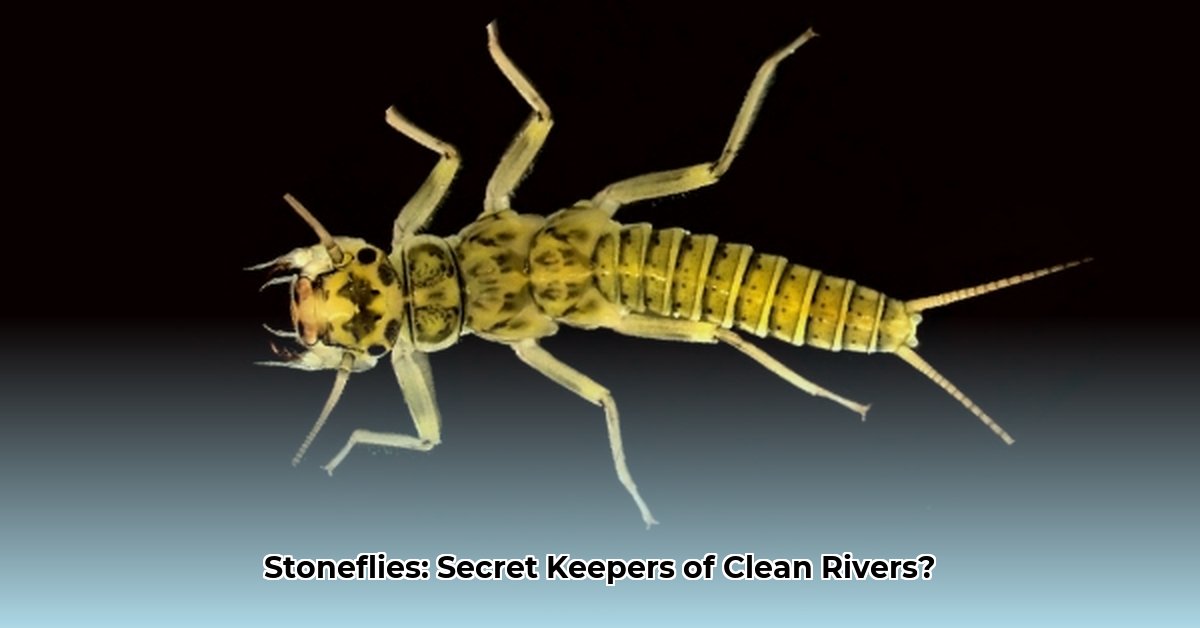Stoneflies (Plecoptera), often unseen inhabitants of our rivers and streams, play a crucial role as indicators of freshwater ecosystem health. Their presence, or absence, can reveal a hidden story about the quality of our water resources. From their intricate life cycle to their sensitivity to pollution, stoneflies offer valuable insights into the well-being of these vital ecosystems. Learn more about other river animals here.
The Stonefly Life Cycle: A Story of Transformation
The stonefly’s life journey is a fascinating metamorphosis, spanning one to four years underwater as nymphs before briefly emerging as winged adults to reproduce. As aquatic nymphs, they thrive in clean, oxygen-rich water, feeding on algae and organic matter. This dependence on pristine conditions makes them particularly vulnerable to environmental changes, serving as an early warning system for ecosystem health.
Stoneflies as Bioindicators: Nature’s Water Quality Report
Stoneflies are exceptionally sensitive to pollution, especially low dissolved oxygen levels and increased water temperatures. A thriving stonefly population signifies a healthy ecosystem, while their decline or absence can indicate underlying problems like pollution or habitat degradation. Different stonefly species exhibit varying tolerances to pollution, providing a nuanced understanding of water quality. The presence of certain species may signal pristine conditions, while the dominance of tolerant species can indicate pollution.
Threats to Stoneflies: A Call for Conservation
Stoneflies face increasing pressures from habitat loss, pollution (agricultural runoff, industrial discharge, sewage), and the escalating impacts of climate change. These threats disrupt their delicate life cycle and underscore the need for proactive conservation efforts. Protecting and restoring riparian zones – the vegetated areas along waterways – is crucial for maintaining stonefly habitats and water quality.
Actionable Steps for Stonefly Conservation: A Collaborative Approach
Protecting stoneflies demands a comprehensive strategy involving research, policy, and individual action. Here are some key steps:
Short-Term Actions (0-1 Year):
- Standardized Monitoring Protocols: Implementing consistent monitoring methods across environmental agencies will provide reliable data on stonefly populations and water quality trends.
- Targeted Research: Prioritizing research on the specific impacts of various pollutants on different stonefly species will inform targeted conservation efforts.
- Angler Education and Outreach: Educating anglers about the importance of stoneflies and promoting responsible fishing practices can help protect these sensitive insects and their habitats.
- Best Management Practices for Land Use: Implementing best management practices in agriculture and other land uses can minimize runoff and pollution, safeguarding water quality for stoneflies.
Long-Term Actions (3-5 Years and Beyond):
- Climate Change Impact Assessments: Long-term studies are essential to understand the complex effects of climate change on stonefly populations and develop adaptive conservation strategies.
- Refined Water Quality Standards: Water quality standards should be refined based on the specific sensitivities of different stonefly species, ensuring adequate protection for these valuable indicators.
- Predictive Modeling: Developing predictive models that incorporate environmental factors, including climate change and pollution, can help anticipate future impacts on stonefly populations and guide proactive conservation measures. Integrating genetic data into these models can further enhance their accuracy and predictive power.
- Riparian Habitat Restoration: Restoring and protecting healthy riparian zones provides crucial habitat for stoneflies and other aquatic organisms, enhancing the overall health of freshwater ecosystems.
- Continued Stakeholder Engagement: Fostering ongoing collaboration among anglers, scientists, policymakers, and the public is vital for the long-term success of stonefly conservation efforts.
Harnessing Stonefly Data for Comprehensive Water Quality Assessment
Stoneflies, along with mayflies (Ephemeroptera) and caddisflies (Trichoptera) – collectively known as the EPT taxa – are highly sensitive indicators of freshwater health. Analyzing stonefly species data provides valuable insights into water quality:
- Species Composition: Identifying the specific types of stoneflies present helps determine the level of water quality. The presence of certain pollution-sensitive species indicates pristine conditions, while the absence of these species or the dominance of tolerant species can suggest pollution.
- Abundance and Diversity: Assessing the abundance and diversity of stonefly species provides a comprehensive picture of ecosystem health. A diverse and abundant stonefly community generally indicates good water quality, while low diversity or the dominance of a few tolerant species can signal pollution or other environmental stressors.
- Long-Term Monitoring and Historical Data: Comparing current stonefly data with historical records from museum collections and other sources provides valuable insights into long-term trends in water quality and the impacts of environmental changes.
- eDNA Metabarcoding: This cutting-edge technology allows scientists to assess the entire EPT community from a single water sample by sequencing environmental DNA (eDNA). eDNA metabarcoding provides a rapid and efficient way to monitor biodiversity and detect changes in water quality, even in remote or difficult-to-access areas.
The Future of Stoneflies: A Shared Responsibility
The fate of stoneflies is intertwined with the health of our freshwater ecosystems. By understanding their ecological significance, implementing effective conservation measures, and embracing innovative monitoring techniques, we can protect these invaluable sentinels and ensure the long-term well-being of our precious water resources. Through collaborative efforts and informed action, we can safeguard these tiny insects and the vital ecosystems they represent for generations to come.
- SYBAU See You Baby Meaning: Gen Z Slang Evolves - July 1, 2025
- Unlock Your Inner Youth: Lifestyle Secrets for a Vibrant Life - July 1, 2025
- Decode SYBAU Meaning: Gen Z Slang Explained - July 1, 2025






